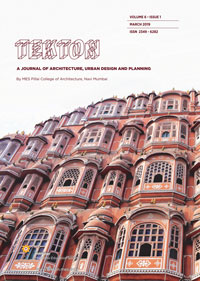Devyani Gangopadhyay and Prathyusha Ravi
Tekton
Volume 6, Issue 1, March 2019
pp. 24 – 39
 Devyani Gangopadhyay is an academician and architect with undergraduate degree from Bengal Engineering College, Kolkata, and a post graduate degree in Planning from Anna University, Chennai. She completed her Doctoral Research from CEPT University, Ahmedabad. With a keen interest in urban development, she continues her research by exploring the urban forms and patterns, urban interventions and their impact on social life of the people. She has published a number of research papers. As an academician her interests include Urban Design, Sustainable Urban and Rural Development, Design Pedagogy.
Devyani Gangopadhyay is an academician and architect with undergraduate degree from Bengal Engineering College, Kolkata, and a post graduate degree in Planning from Anna University, Chennai. She completed her Doctoral Research from CEPT University, Ahmedabad. With a keen interest in urban development, she continues her research by exploring the urban forms and patterns, urban interventions and their impact on social life of the people. She has published a number of research papers. As an academician her interests include Urban Design, Sustainable Urban and Rural Development, Design Pedagogy.
gdevyani00@yahoo.co.in
 Prathyusha Ravi is a budding Conservation Architect who graduated from CEPT University. She is passionate about Local Histories, transmission of Oral Knowledge and Culture Studies. She documented the “Crafting of Tanjore Dolls” being a UNESCO – Sahapedia Research Fellow and received INTACH Scholarship 2017 for studying the “Shilpis and Sthapatis of Chettinad”. She has been researching on heritage conservation, indigenous knowledge systems and urban studies. She is currently trying to find a balance between her academic pursuits and
Prathyusha Ravi is a budding Conservation Architect who graduated from CEPT University. She is passionate about Local Histories, transmission of Oral Knowledge and Culture Studies. She documented the “Crafting of Tanjore Dolls” being a UNESCO – Sahapedia Research Fellow and received INTACH Scholarship 2017 for studying the “Shilpis and Sthapatis of Chettinad”. She has been researching on heritage conservation, indigenous knowledge systems and urban studies. She is currently trying to find a balance between her academic pursuits and
architectural practice.
prathyushanilakantan@gmail.com
ABSTRACT
Traditionally the neighborhoods in many parts of India grew around religious institutions, commercial centres, or water bodies and the residents thereby shared some common socio-cultural, economic backgrounds. However, post-independence there are some modernist and planned neighborhoods developed which were promoted by the housing boards and other planning authorities where the plots or houses could be bought by anyone irrespective of their caste, class, occupation. The paper studies one such neighborhood called Kalaignar Karunanidhi Nagar in Chennai which was planned and promoted by Tamil Nadu Housing board. The paper attempts to study the performance of this neighborhood which was resided by people with diverse background. In the present-day context, the government is promoting the “Smart City Mission” with the aim of providing the citizens a decent quality of life. The study attempts to evaluate how the neighborhood performs with respect to smartness as defined by India’s “Smart City Mission”. Opinion and satisfaction level of the residents is considered to be the main tool to test the success of the neighborhood. Results of the study show that the neighborhood which is five decades old fares quite satisfactorily in its smartness even today proving that efficient planning of a neighborhood makes it innately smart and cosmetic changes in the name of smartness may not help.
KEY WORDS
Modernist Neighborhood, Smart Neighborhood, Sense of Belonging, Level of Satisfaction, Social Spaces, Walkable Locality


